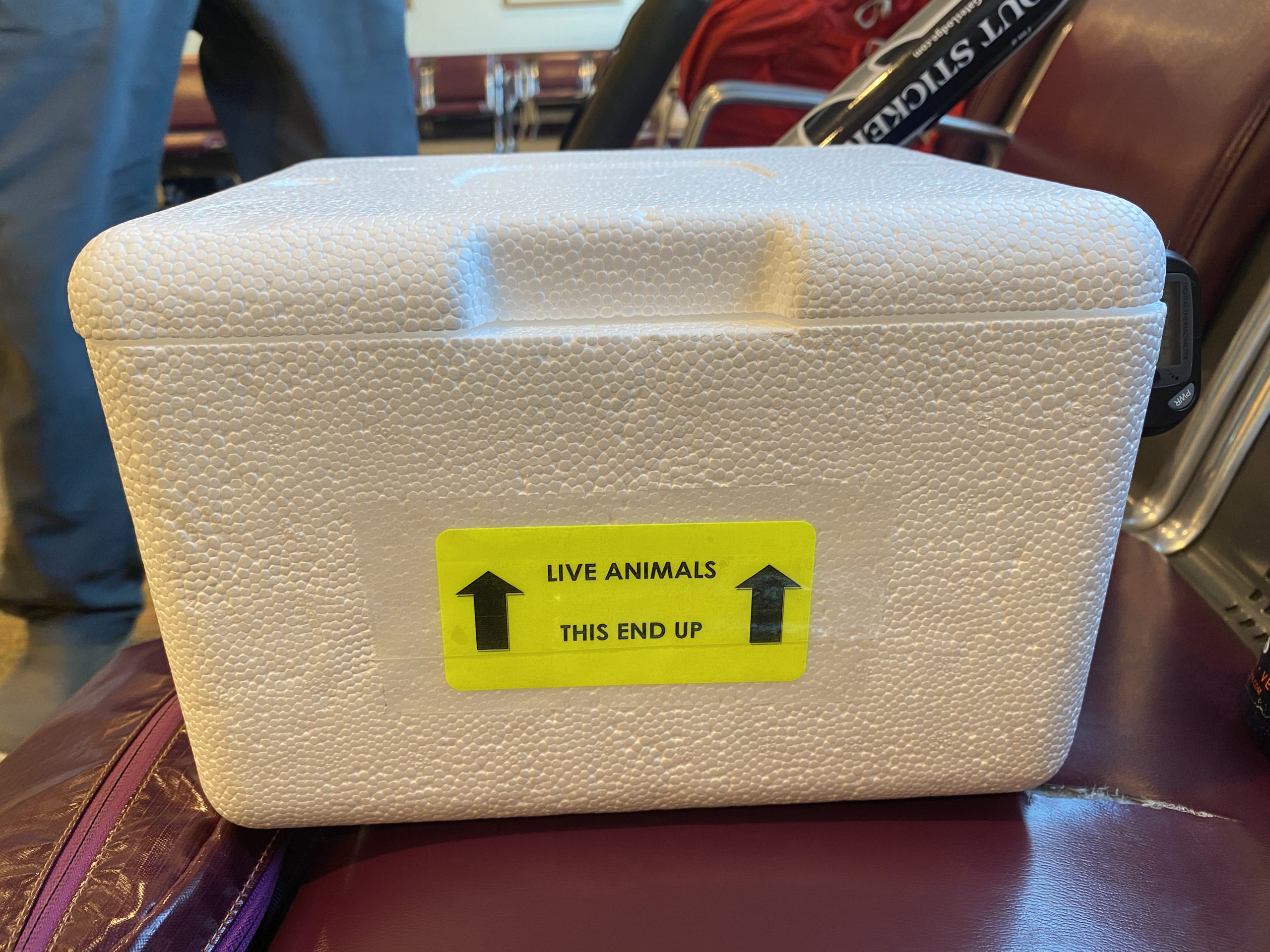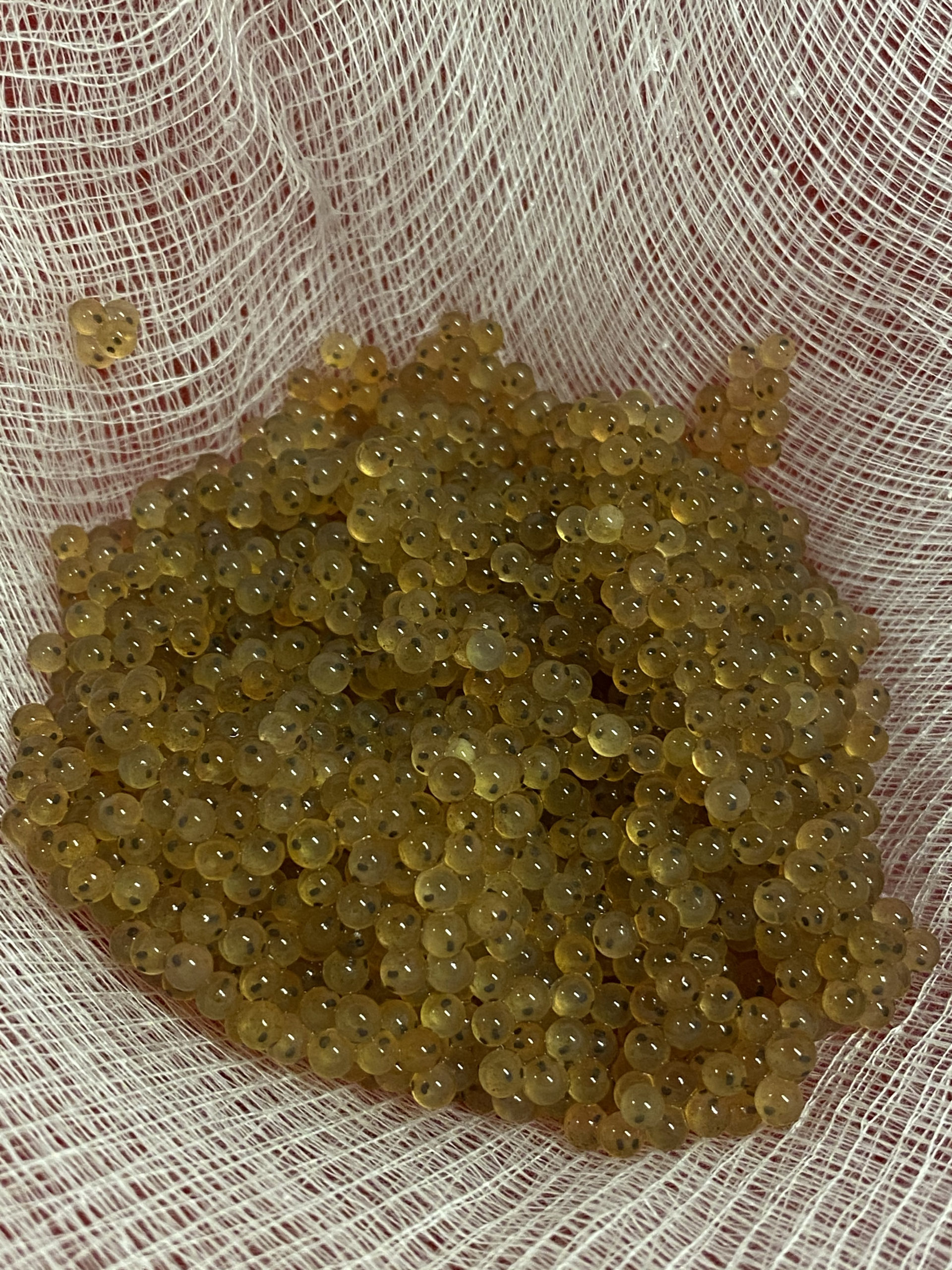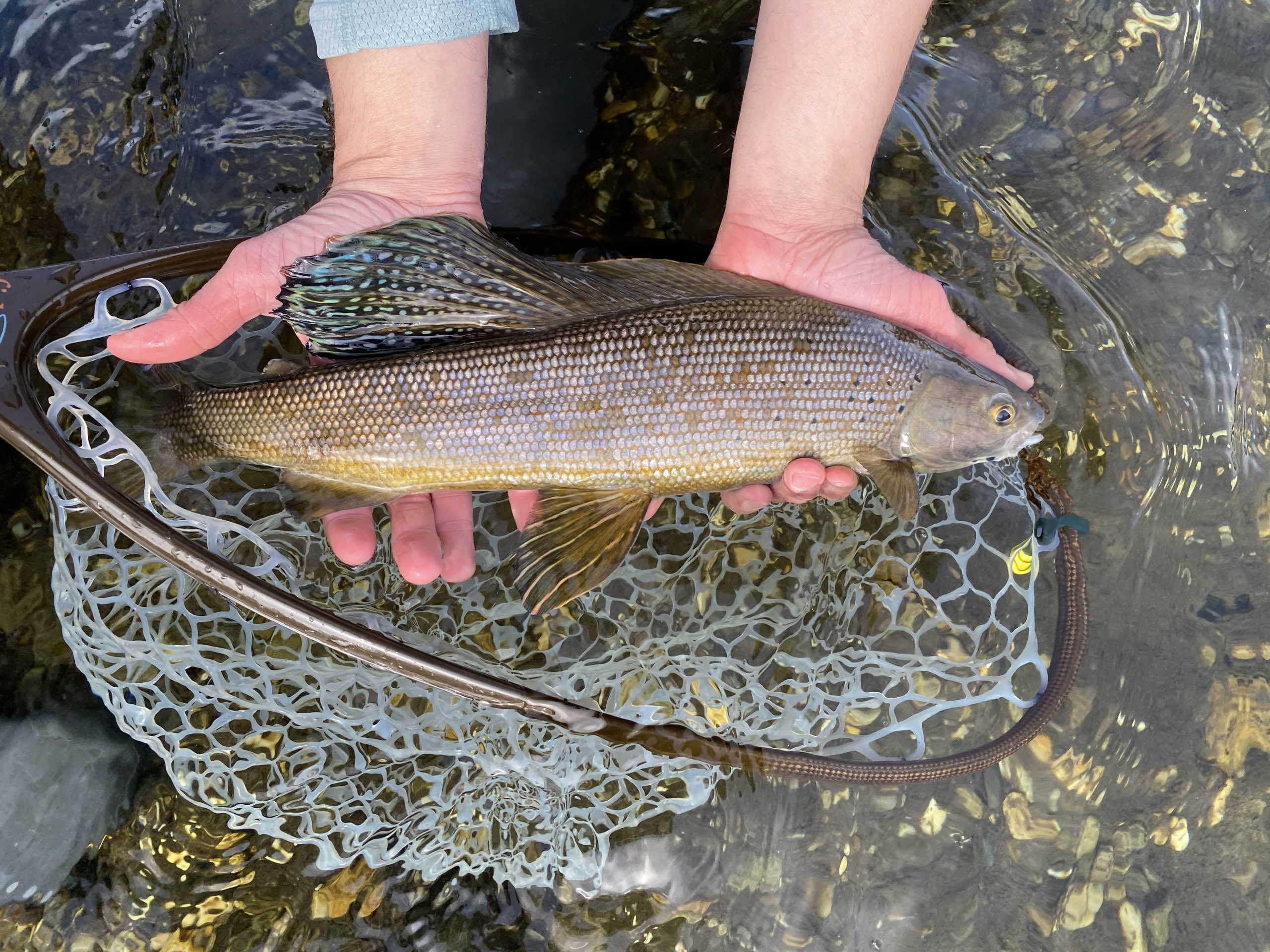
Every year, Nicole and Tom Watson take a trip to Alaska. Like the typical tourist, they enjoy fly fishing and experiencing the untamed wilderness, yet their visit is no ordinary vacation. Among their duffel bags and backpacks, there’s a special piece of carry-on luggage: a carefully sealed container of fish eggs.
The eggs are from arctic grayling, a native fish that has long been gone from Michigan’s waters. Currently, the grayling only lives on in the culture of northern Michigan, from artwork to whiskey to the name of a town where it once lived in abundance.
“The town of Grayling is actually named after the fish, and unfortunately the fish is no longer here,” Nicole Watson said. “You see the pictures of grayling, the mounts of grayling, the artwork, and to not have them actually in the streams in a community that relies so heavily on the fishing industry, it’s really a shame.”

Alaskan grayling eggs are shown packaged and ready for flight to Michigan in the airport. (Photo Credit: Nicole Watson)
Watson, a PhD student at Michigan State University, brings the arctic grayling eggs back to her lab to rear them. The eggs and the research Watson conducts with them are the foundation of Michigan’s Arctic Grayling Initiative, a collaboration between the Michigan Department of Natural Resources, the Little River Band of Ottawa Indians and 45 regional partners.
The goal: bringing the arctic grayling back to northern Michigan.
“It’s good to be able to be having an impact and hopefully bring them back,” Watson said.
The initiative started in 2016 with the goal of reintroducing grayling to the rivers where they were historically located. Some 20 rivers in northern Michigan fall into this category, but that doesn’t necessarily mean arctic grayling will be reintroduced into all of them, or even to Grayling itself.
To be considered for grayling reintroduction, communities must submit a nomination to the DNR. After the nomination is received, the DNR and tribal organizations conduct a survey of the conditions to determine if reintroduction is feasible. The Upper Manistee, Boardman and Jordan River watersheds are a few of the nominations received so far. Grayling have not been reintroduced to any river as of yet.
“Back in the 1800s, (grayling) were very common in Michigan. But because of several factors – habitat degradation, logging practices at the time, destruction of habitat and overfishing – they were wiped out by the early 1900s,” said Todd Grischke, the assistant chief of the Fisheries Division for the DNR.
Grischke compared the arctic grayling to the lake sturgeon. Both were once abundant in Michigan but had their populations drastically reduced or eliminated due to human activity.
“They were part of the original ecosystem and native, and therefore they have a place. Culturally, they’re significant to Native Americans, to European settlers and to your current generations, because they stand for something. They have intrinsic value just because they’re here. And that means something to people,” he said.
If at first you don’t succeed, follow Montana’s example
This isn’t the first attempt to reintroduce arctic grayling into Michigan’s waters. In the 1980s, the DNR stocked yearlings raised in a hatchery in several lakes and streams in Michigan, but that attempt failed due to rapid out-migration. In other words, after the grayling were stocked, they simply disappeared.

Nicole Watson examines grayling eggs at her Michigan State University Lab. (Photo Credit: Nicole Watson)
According to Watson, this failure could have occurred because the hatchery-raised grayling lacked familiarity with the water they were stocked in.
“The fish basically don’t know what the water smells like that they’re put in. They imprinted to the hatchery at that point, so when you put them in a stream, they have no idea where they are,” she said.
For a solution to this problem, Watson turned to a successful grayling restoration initiative in Montana that found a solution to rapid out-migration by using a remote site incubator. By circulating water from the stream the grayling will be introduced to upon release, the remote site incubator allows them to be raised on-site from the eyed-egg stage.
“It allows those young grayling, even as early as the eyed-egg stage, to imprint to that water that you want to introduce them to,” Watson said. “Since Montana has been so successful, that’s what Michigan is doing as well.”
Watson is also researching the impact of competition and predation rates between young arctic grayling and brook and brown trout, the salmonids that grayling will be most likely to encounter once reintroduced.

Eyed grayling eggs (Photo Credit: Nicole Watson)
“In the presence of brook trout, grayling do very well; their growth isn’t limited, but brown trout do have a negative impact on grayling, as far as competition goes,” Watson said. “And both brook trout and brown trout will prey upon grayling fry, but the predation rate decreases over time as the grayling fry develop.”
Watson says that it is a combination of this research and collaboration between the partners that sets this initiative apart from previous reintroduction attempts and will make it successful in the end.
“It’s not just the DNR going out and saying, ‘We’re going to try and reintroduce grayling,’” she said. “You have everything from distilleries that are on board trying to support the grayling reintroduction to stakeholder groups and universities, and tribal organizations with the state as well, all working together. It’s a grassroots type of initiative.”
An invested community
The Manistee County Community Foundation is one of the many partners in the initiative, joining in 2019 to support the Manistee-based Little River Band of Ottawa Indians.
“Our Manistee County waters are among those that once were home to the iconic Arctic grayling and we’re thrilled to engage philanthropy, to support our local partners, and to join others throughout the state to help return this once native species to Michigan,” MCCF President and CEO Laura Heintzelman said in a statement.
MCCF was also approached by the Iron Fish Distillery in Thompsonville, Michigan, about establishing the Iron Fish Arctic Grayling Initiative Fund, a vehicle for charitable donations to the initiative. Iron Fish Distillery even dedicated their inaugural whiskeys to the restoration efforts.
Joe Hemming is president of Anglers of the AuSable, another partner in the initiative. He said his organization has concerns about the effect grayling could have if reintroduced into the Au Sable River. These include the effect grayling could have on trout, management priorities once grayling are reintroduced, and who would make decisions in the long run.

Nicole Watson prepares to release a grayling she caught while fishing in Alaska, where grayling are abundant. (Photo Credit: Nicole Watson)
“Regarding reintroduction of grayling fish into the Au Sable River, our organization is taking a ‘wait and see’ approach and not recommending reintroduction of the grayling fish into the Au Sable River until our concerns are addressed,” Hemming said in a statement to Great Lakes Now.
Still, Hemming hopes to see grayling raised for the initiative in the Grayling Fish Hatchery.
“After all, the town of Grayling takes its name from this beautiful fish. Having grayling at the hatchery would be a wonderful opportunity to both educate and introduce the public to the grayling fish,” he said.
Right now, only the Oden State Fish Hatchery and the Marquette State Fish Hatchery are being used in the initiative. The DNR plans to use eggs from the fish raised in these hatcheries once the grayling are sexually mature, meaning there likely won’t be eggs in any river until 2025.
According to Watson, it will likely be another 20 years after those first eggs are introduced before the end goal of a self-sustaining grayling population is achieved.
“It’s a long-term project,” she said. “It’s not ‘introduce them, a couple years, and then boom, we have a viable fishery.’ It’s going to take some patience. It’s going to take some time, but the overall goal is to have a self-sustaining population of grayling in Michigan once again.”
Still, with continued community support, Watson thinks that the restoration will happen and the arctic grayling will once again swim in Michigan’s waters.
“We did it for turkey. We did it for elk,” Watson said. “Why not for grayling, too?”
For more information and ways to get involved, check out the website for Michigan’s Arctic Grayling Initiative here.
Catch more news on Great Lakes Now:
I Speak for the Fish: Shell middens reveal interesting clues about the humble muskrat
The Farmory: Is indoor fish farming a viable way of tackling declining fish populations?
The Suckers: Great Lakes’ “best supporting fishes” are important to the food web
API key not valid. Please pass a valid API key.Featured image: Nicole Watson shows off the grayling she caught while fly fishing in Alaska, where grayling are abundant. (Photo Credit: Nicole Watson)




